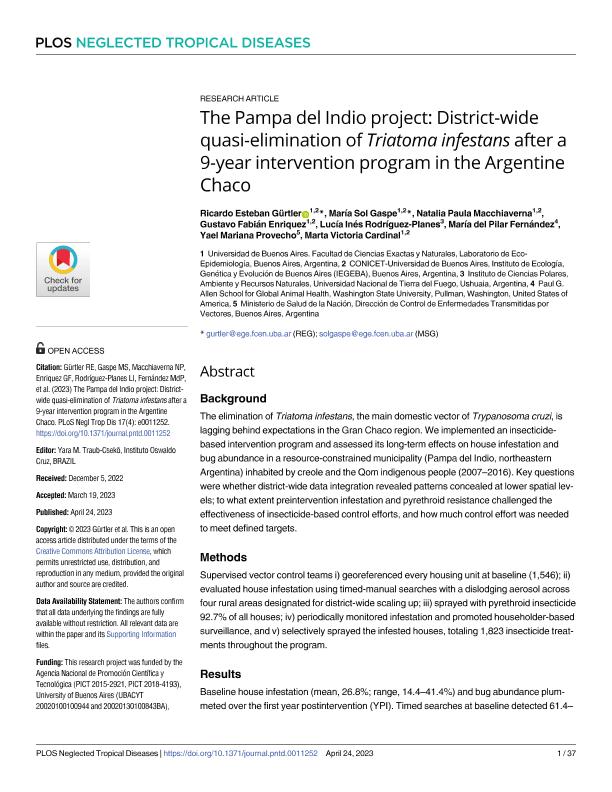Artículo
The Pampa del Indio project: District-wide quasi-elimination of Triatoma infestans after a 9-year intervention program in the Argentine Chaco
Gurtler, Ricardo Esteban ; Gaspe, Maria Sol
; Gaspe, Maria Sol ; Macchiaverna, Natalia Paula
; Macchiaverna, Natalia Paula ; Enriquez, Gustavo Fabián
; Enriquez, Gustavo Fabián ; Rodríguez Planes, Lucía Inés
; Rodríguez Planes, Lucía Inés ; Fernandez, Maria del Pilar
; Fernandez, Maria del Pilar ; Provecho, Yael Mariana
; Provecho, Yael Mariana ; Cardinal, Marta Victoria
; Cardinal, Marta Victoria
 ; Gaspe, Maria Sol
; Gaspe, Maria Sol ; Macchiaverna, Natalia Paula
; Macchiaverna, Natalia Paula ; Enriquez, Gustavo Fabián
; Enriquez, Gustavo Fabián ; Rodríguez Planes, Lucía Inés
; Rodríguez Planes, Lucía Inés ; Fernandez, Maria del Pilar
; Fernandez, Maria del Pilar ; Provecho, Yael Mariana
; Provecho, Yael Mariana ; Cardinal, Marta Victoria
; Cardinal, Marta Victoria
Fecha de publicación:
04/2023
Editorial:
Public Library of Science
Revista:
PLoS Neglected Tropical Diseases
ISSN:
1935-2727
e-ISSN:
1935-2735
Idioma:
Inglés
Tipo de recurso:
Artículo publicado
Clasificación temática:
Resumen
Background The elimination of Triatoma infestans, the main domestic vector of Trypanosoma cruzi, is lagging behind expectations in the Gran Chaco region. We implemented an insecticide-based intervention program and assessed its long-term effects on house infestation and bug abundance in a resource-constrained municipality (Pampa del Indio, northeastern Argentina) inhabited by creole and the Qom indigenous people (2007–2016). Key questions were whether district-wide data integration revealed patterns concealed at lower spatial lev-els; to what extent preintervention infestation and pyrethroid resistance challenged the effectiveness of insecticide-based control efforts, and how much control effort was needed to meet defined targets. Methods Supervised vector control teams i) georeferenced every housing unit at baseline (1,546); ii) evaluated house infestation using timed-manual searches with a dislodging aerosol across four rural areas designated for district-wide scaling up; iii) sprayed with pyrethroid insecticide 92.7% of all houses; iv) periodically monitored infestation and promoted householder-based surveillance, and v) selectively sprayed the infested houses, totaling 1,823 insecticide treatments throughout the program. Results Baseline house infestation (mean, 26.8%; range, 14.4–41.4%) and bug abundance plum-meted over the first year postintervention (YPI). Timed searches at baseline detected 61.4– 88.0% of apparent infestations revealed by any of the methods used. Housing dynamics varied widely among areas and between Qom and creole households. Preintervention tria-tomine abundance and the cumulative frequency of insecticide treatments were spatially aggregated in three large clusters overlapping with pyrethroid resistance, which ranged from susceptible to high. Persistent foci were suppressed with malathion. Aggregation occurred mainly at house compound or village levels. Preintervention domestic infestation and abundance were much greater in Qom than in creole households, whereas the reverse was recorded in peridomestic habitats. House infestation, rare (1.9–3.7%) over 2–6 YPI, averaged 0.66% (95% confidence interval, 0.28–1.29%) at endpoint. Conclusions Upscale integration revealed multiple coupled heterogeneities (spatial, sociodemographic and biological) that reflect large inequalities, hamper control efforts, and provide opportuni-ties for targeted, sustainable disease control. High-coverage, professional insecticide spraying combined with systematic surveillance-and-response were essential ingredients to achieve the quasi-elimination of T. infestans within 5 YPI and concomitant transmission blockage despite various structural threats and constraints.
Archivos asociados
Licencia
Identificadores
Colecciones
Articulos(IEGEBA)
Articulos de INSTITUTO DE ECOLOGIA, GENETICA Y EVOLUCION DE BS. AS
Articulos de INSTITUTO DE ECOLOGIA, GENETICA Y EVOLUCION DE BS. AS
Citación
Gurtler, Ricardo Esteban; Gaspe, Maria Sol; Macchiaverna, Natalia Paula; Enriquez, Gustavo Fabián; Rodríguez Planes, Lucía Inés; et al.; The Pampa del Indio project: District-wide quasi-elimination of Triatoma infestans after a 9-year intervention program in the Argentine Chaco; Public Library of Science; PLoS Neglected Tropical Diseases; 17; 4; 4-2023; 1-37
Compartir
Altmétricas



